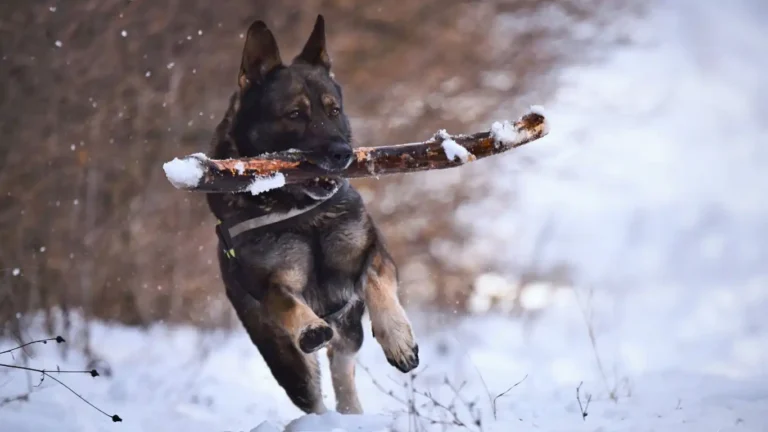How to Protect Your Dog’s Joints on Long Hikes – Essential Tips for Safety
Hiking with your dog is one of the most fulfilling outdoor adventures, offering both you and your furry companion an opportunity to enjoy the beauty of nature together. However, before you embark on a long hike with your dog, it’s essential to keep in mind that such physical exertion can be tough on their joints. This is particularly important for dogs that are still growing, older dogs, or those with existing joint issues. So, how do you protect your dog’s joints on long hikes and ensure they’re comfortable throughout the adventure? In this article, we’ll go over some practical tips, based on my experience as a Veterinary Assistant with a focus on pet nutrition, to keep your dog’s joints in top condition while you both explore the great outdoors.
Understanding Dog Joint Health: Why It Matters on Hikes

Before diving into the tips, it’s crucial to understand why joint health matters so much when it comes to hiking. A dog’s joints, especially their hips, knees, and elbows, are responsible for much of their mobility. Just like humans, dogs can suffer from wear and tear, arthritis, or other degenerative joint conditions. Long hikes, particularly on rough or uneven terrain, can stress these joints and lead to inflammation or long-term damage.
In fact, many dogs can develop joint problems as they age, which makes it even more important to take extra precautions to protect their joints on long hikes. Even active breeds that love running and jumping, like Border Collies or Huskies, can be at risk if not properly supported and prepared. But don’t worry—there are several ways to help protect your dog’s joints and ensure they stay healthy and strong through every adventure.
Warm-Up and Cool Down: Essential Steps to Prevent Injury
The Importance of Warming Up

Just like you wouldn’t start a long hike without stretching your own muscles, your dog needs a warm-up too. This is a critical step in preventing joint injury. When your dog begins a hike, their muscles and joints are still cold and stiff. A proper warm-up allows their body to prepare for the physical demands ahead, improving flexibility and circulation to the joints.
Here’s a simple warm-up routine that works well for most dogs:
- Start with a short, slow-paced walk for about 5 to 10 minutes. This will get the blood flowing to their muscles.
- Do some gentle stretches. You can encourage your dog to stretch by having them bend their neck towards their shoulders or encouraging them to stretch their back by offering a treat that they can reach behind their body.
- Gradually increase the pace to a brisk walk before moving to more intense activity like running or hiking uphill.
Don’t Skip the Cool Down
Equally important is cooling down after the hike. Just like with warm-ups, cooling down after a hike gives your dog’s muscles and joints time to relax and recover. It’s especially important to avoid letting your dog immediately stop and collapse after a long hike. Instead, guide them through a 5 to 10-minute cool-down walk at a slower pace. This gives their body a chance to adjust back to a resting state, reducing stiffness and the risk of soreness the next day.
Proper Nutrition for Joint Health: A Crucial Element
As a Veterinary Assistant, I can’t stress enough how important nutrition is for maintaining your dog’s joint health—especially during and after physically demanding activities like hiking. The right balance of nutrients supports healthy joint function and can even help reduce inflammation.
Key Nutrients for Joint Support
When choosing food for your dog, look for ingredients that promote joint health. Key nutrients include:
- Glucosamine and Chondroitin: These compounds are often included in joint supplements and help support cartilage health and reduce inflammation in the joints.
- Omega-3 Fatty Acids: Found in fish oils and flaxseed, omega-3s are known for their anti-inflammatory properties, which help reduce joint pain and stiffness.
- Collagen: Collagen is an important protein that helps support the structure of the joints and cartilage.
- Vitamin C and E: Both of these vitamins have antioxidant properties that help protect the joints from oxidative damage and support overall joint health.
Aside from their regular diet, consider adding joint supplements to your dog’s routine. Many veterinarians recommend glucosamine and chondroitin supplements for dogs that engage in high levels of activity. But always check with your vet first to ensure you’re providing the right dosage and supplement type for your dog’s specific needs.
Maintaining a Healthy Weight: Preventing Joint Strain

Carrying excess weight puts unnecessary strain on your dog’s joints. For example, a dog that is overweight may develop joint problems more quickly, especially in their hips and knees. These issues are often compounded during strenuous activities like hiking, where the joints must absorb more impact with each step.
If your dog is slightly overweight, it’s essential to work with your veterinarian to create a weight loss plan before going on long hikes. The plan should include a balanced diet and regular exercise to gradually reduce your dog’s weight while maintaining joint health. Additionally, regular checkups with your vet will help monitor your dog’s progress and keep track of any potential joint concerns.
Now, while it’s tempting to treat your dog to lots of snacks during the hike, be mindful of their caloric intake. Overfeeding or giving too many treats can contribute to weight gain, which is the last thing you want when it comes to protecting their joints.
Conclusion
Properly preparing your dog for a long hike is a mix of ensuring they’re physically ready, maintaining their joint health through nutrition and weight management, and being mindful of how much strain their body is under during the hike. In the next section, we’ll dive into additional protective gear for your dog and how to modify your hikes to keep their joints safe.
Choosing the Right Hiking Terrain for Your Dog’s Joints

Choosing the right terrain for your hike is another essential factor in protecting your dog’s joints. The terrain can have a significant impact on how much strain your dog’s joints experience. While some dogs thrive on rocky, uneven trails, others may struggle or even hurt themselves in such conditions.
In my experience as a Veterinary Assistant, I’ve seen dogs with joint problems, particularly senior dogs, benefit from gentler, more forgiving trails. So, when planning your hike, always consider your dog’s physical condition and joint health. Here are some tips on selecting the best terrain:
- Soft, grassy paths: These trails provide a cushion for your dog’s joints, reducing the impact with each step. They’re especially beneficial for older dogs or those with arthritis.
- Gentle, well-maintained trails: Smooth, flat trails are much easier on your dog’s joints than steep, rocky ones. If you’re hiking with a dog that has mobility issues, consider finding trails with minimal elevation changes.
- Avoiding rocky or uneven surfaces: While adventurous dogs might love these challenging terrains, they can put excessive strain on joints, particularly the knees and hips. Be cautious if your dog has a history of joint problems.
If you can, try to choose trails that are primarily dirt or grass. They provide a good balance between being easy on your dog’s joints and offering an enjoyable hiking experience. While some dogs might be able to handle more difficult terrain, it’s always better to err on the side of caution, especially for younger or older dogs.
Investing in Joint Protection Gear for Your Dog

In addition to being mindful of the terrain, investing in joint protection gear for your dog can be a game-changer. I’ve seen firsthand how products like joint braces or paw protection gear can reduce strain on your dog’s joints and make hiking much more comfortable.
Here are some of the most effective joint protection gear options for dogs that can help support them during long hikes:
- Joint braces: These braces are designed to support a dog’s knees, elbows, or hips. They’re especially useful for dogs with existing joint issues like arthritis or those recovering from injuries. I’ve had clients report a significant improvement in their dog’s comfort levels after adding a brace to their routine, especially on longer hikes.
- Paw protectors: If you’re hiking on rough, rocky terrain, paw protectors can prevent cuts, bruising, and irritation. Some dogs are more prone to paw injuries than others, and these booties can offer an extra layer of protection. They also help your dog maintain traction on slippery surfaces.
- Supportive harnesses: A well-designed harness can help you control your dog’s movements while hiking, preventing them from overexerting themselves. Some harnesses also include extra padding around the joints for added comfort and support.
When choosing gear, always make sure it’s the right size and fits properly. Ill-fitting gear can actually cause more harm than good, leading to discomfort or injury. I always recommend taking your dog on short trial hikes first to ensure the gear works well before going on longer adventures.
Know Your Dog’s Limits: Pacing and Rest Breaks

One of the most important things you can do for your dog’s joints on a long hike is knowing their limits. It’s easy to get caught up in the excitement of the hike, but pushing your dog too hard can lead to injury or exhaustion. If you’re hiking with an active breed, it’s especially important to monitor them closely for signs of fatigue, pain, or discomfort.
Here’s how to ensure your dog doesn’t overdo it:
- Pacing yourself: Start with a slow, steady pace. Let your dog set the tempo, especially if they’re not used to long hikes. Dogs with joint issues may not be able to keep up with a fast pace, and it’s important to let them take breaks when needed.
- Frequent rest breaks: Plan for regular rest stops, especially if you’re hiking for an extended period. I recommend taking a break every 30 to 45 minutes to let your dog rest, hydrate, and catch their breath. Use this time to check in with your dog and make sure they’re feeling comfortable.
- Signs of fatigue: Be aware of subtle signs of fatigue or discomfort. If your dog starts lagging behind, limping, or showing signs of distress, it’s time to slow down and take a longer break. Pushing through these signs can lead to injury.
While it’s tempting to let your dog run and explore freely, remember that long hikes can be tiring on their joints, even if they seem excited. Allow them to take their time and enjoy the experience at their own pace. And remember—rest is just as important as the hike itself!
Hydration and Nutrition on the Trail
Proper hydration and nutrition are just as critical as physical protection when it comes to protecting your dog’s joints on long hikes. When your dog gets dehydrated, their muscles and joints can stiffen, which can increase the risk of injury.
Always bring plenty of fresh water for both you and your dog. Consider carrying a collapsible bowl that makes it easy to stop for water breaks throughout the hike. Additionally, if you’re hiking for an extended period, you may want to bring along some high-quality snacks or even meals to replenish your dog’s energy.
Some great snack options for hikes include:
- Energy-packed treats: Look for treats that contain healthy fats, protein, and fiber to fuel your dog’s body without weighing them down.
- Joint-supporting chews: There are a variety of chew snacks formulated with glucosamine and chondroitin, designed to support your dog’s joint health during physical activities.
- Homemade options: If you prefer to prepare your own dog snacks, consider making homemade jerky from lean meats or dehydrated fruits. Just make sure they don’t contain any harmful ingredients.
Keep in mind that hiking burns a lot of energy, and dogs often need more fuel than usual during these activities. Keep an eye on your dog’s energy levels and make sure they stay properly fueled for the journey ahead.
Recognizing Joint Issues Early: When to Seek Veterinary Help

As a dog parent, one of the most critical things you can do to protect your dog’s joints on long hikes is recognizing when something isn’t right. Even the best precautions can’t always prevent injuries or underlying joint problems from cropping up. Early detection is key to managing and preventing long-term damage. Fortunately, many signs of joint discomfort or injury are fairly noticeable. If you notice any of these warning signs, it’s essential to seek veterinary help promptly:
- Stiffness or limping: If your dog starts limping, avoiding putting weight on one leg, or seems stiff after a hike, it could be a sign of joint pain. This is especially true if the limp persists or worsens after a few hours of rest.
- Reluctance to move: Dogs with joint pain often become less active. If your dog starts hesitating to jump into the car, climb stairs, or follow you on hikes, it could indicate discomfort in their joints.
- Excessive licking or chewing of joints: Dogs will sometimes lick or chew at an affected joint in an attempt to relieve discomfort. This behavior can also be a sign of arthritis or a soft tissue injury.
- Behavior changes: Dogs in pain might become more irritable, withdraw from play, or even growl when touched near their joints. Any sudden behavioral change should not be ignored.
If you notice any of these signs, it’s important to visit your veterinarian. They can perform a thorough exam, possibly including X-rays, to evaluate your dog’s joint health. By catching joint issues early, you can prevent the condition from worsening and affecting your dog’s quality of life.
Exercise Modifications and Alternatives: Caring for Senior or Injured Dogs
If your dog is older or has suffered a joint injury, long hikes may no longer be appropriate. But that doesn’t mean they can’t still enjoy regular exercise. Modifying your dog’s exercise routine to accommodate their joint health can help them stay fit and active without putting unnecessary stress on their joints. Here are some ways to adjust their physical activity:
- Shorter, more frequent walks: Instead of long hikes, consider taking your dog on several shorter walks throughout the day. These can be gentler on their joints while still providing ample exercise.
- Low-impact activities: Swimming is an excellent low-impact exercise for dogs with joint problems. The buoyancy of the water supports their joints, reducing strain while still allowing them to move and exercise.
- Interactive play: Engaging in low-impact play, such as fetch in a soft yard or gentle tug-of-war, can also keep your dog mentally and physically stimulated without overloading their joints.
For dogs with advanced joint issues, your veterinarian may recommend specific rehabilitation exercises or even physical therapy to strengthen the muscles around their joints and improve their range of motion. Rehabilitation can be incredibly beneficial in managing joint pain and improving mobility, so don’t hesitate to explore these options with your vet.
Creating a Joint Health Plan: The Role of Regular Veterinary Visits
Ultimately, the key to protecting your dog’s joints and ensuring a long, active life is proactive care. Developing a joint health plan with the help of your veterinarian is the best way to keep your dog in top shape for outdoor adventures.
Your vet will consider your dog’s age, breed, activity level, and any previous injuries when creating a joint care strategy. Regular check-ups will allow you to stay on top of your dog’s joint health and catch any potential issues before they become significant problems. For example, some dogs are genetically predisposed to hip dysplasia, so early screening can help detect this condition before it causes pain or immobility.
Besides regular vet visits, joint supplements and medications may be part of your dog’s long-term joint health plan. Many dogs benefit from joint supplements that contain glucosamine, chondroitin, or omega-3 fatty acids. If your dog has existing joint problems, your vet may also recommend pain management strategies, such as anti-inflammatory medications or acupuncture.
Having a joint health plan ensures that you’re providing your dog with the best possible care and setting them up for a lifetime of enjoyable hikes and outdoor adventures. And the peace of mind that comes with knowing you’re doing everything you can to protect your dog’s joints is invaluable!
References
To further explore joint health for dogs and get expert advice on hiking and exercise, check out these trusted resources:
- American Kennel Club (AKC) – Expert advice on dog health, including joint care and exercise tips.
- PetMD – Comprehensive articles and expert advice on pet health and wellness.
- National Institutes of Health (NIH) – Research and information on joint health and inflammation.
- Health.com – A trusted source for overall health and wellness, including tips on joint health and prevention.
Disclaimer
This article is for informational purposes only and does not substitute for professional veterinary advice. Always consult your veterinarian before making any changes to your dog’s diet, exercise routine, or health regimen. Each dog is unique, and only your vet can provide personalized recommendations for your dog’s specific health needs.






